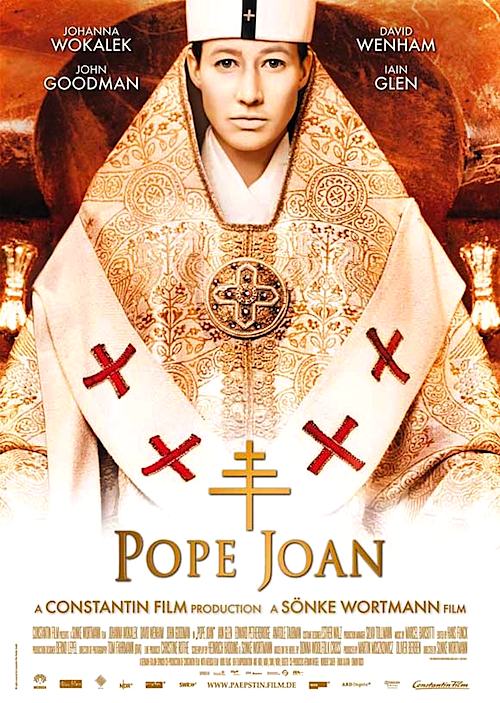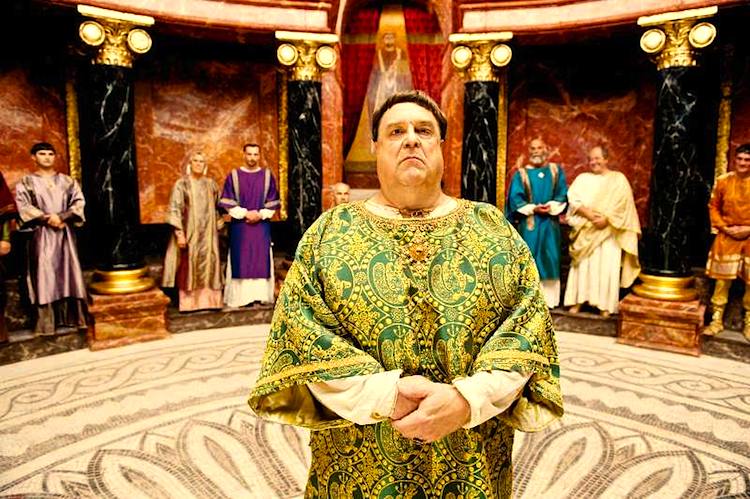 By Joe Bendel. She was a figure of anti-Catholic lore largely but not decisively debunked by Protestant scholars. For centuries millions truly believed in the existence of a legendary female Pope. Indeed, enough references could be found in various sources (before you ask, this definitely includes Martin of Troppau’s Chronicon Pontificum et Imperatorum) to provide Donna Woolfolk Cross the hooks on which to hang a speculative novel about Johanna Anglicus, the woman who would be Pope (allegedly). The most likely apocryphal and very definitely controversial story comes to television when director-co-adapter Sönke Wortmann’s Pope Joan (trailer here), debuted this past Sunday on ReelzChannel.
By Joe Bendel. She was a figure of anti-Catholic lore largely but not decisively debunked by Protestant scholars. For centuries millions truly believed in the existence of a legendary female Pope. Indeed, enough references could be found in various sources (before you ask, this definitely includes Martin of Troppau’s Chronicon Pontificum et Imperatorum) to provide Donna Woolfolk Cross the hooks on which to hang a speculative novel about Johanna Anglicus, the woman who would be Pope (allegedly). The most likely apocryphal and very definitely controversial story comes to television when director-co-adapter Sönke Wortmann’s Pope Joan (trailer here), debuted this past Sunday on ReelzChannel.
Like the other Joan, the life of Johanna (not yet known as Anglicus) will be short but epic. Her father is a priest from Britain who came to convert the godless Saxons. Unfortunately, most of his zeal is reserved for terrorizing his family. Despite her natural aptitude and general thirst for knowledge, he refuses to allow her any formal education. However, through the intercession of an unusually progressive Bishopric, Johanna eventually begins her studies at the Cathedral school, while staying as a guest of Count Gerold. She quickly forms a deep emotional bond with the Count, but not so much with the Countess.
War will soon disrupt their lives, but it offers Johanna the opportunity to assume her younger brother’s identity and take his place in a monastic order. There she will begin her ecclesiastic career, living in constant fear her secret will be revealed.
Pope Joan is not exactly a love letter to the Church (there was only one at the time), but not all of the clergy depicted are intolerant Savonarolas. In fact, at critical junctures of her life, Johanna is championed or protected by many men of the cloth, usually of the older and wiser variety. Frankly, one of the most sympathetic characters is Pope Sergius II, whom Anglicus (as he/she is then known) loyally serves. Still, her dogmatic father is so unremittingly abusive, it makes several of the early scenes punishingly difficult to watch.
Despite the gender-bending element of Anglicus’s supposedly suppressed story, Pope Joan is not really preoccupied with psycho-sexual issues. Instead, it is a more traditional feminist critique of an old world social order that afforded little or no opportunities to women. It does so with healthy doses of war, pestilence, and intrigue.

Having previously played an acting president on The West Wing, an unlikely British monarch in King Ralph – and the mother of all governors, Huey P. Long – John Goodman rounds out his resume with the portrayal of a Pope. While he somewhat stands out amid the European cast, his larger than life presence fits Sergius nicely.
Obviously, Johanna is the trickiest part to cast, because she must be boyish enough to pass for male, yet feminine enough to attract the attention of the manly Count Gerold. Frankly, that is probably impossible, but Johanna Wokalek has enough of a Tilda Swinton vibe to suspend disbelief in each context. With credits including The Lord of the Rings trilogy and 300, David Wenham brings plenty of hack-and-slash action credibility to the proceedings as Gerold, also developing some relatively convincing chemistry with Wokalek.
Pope Joan follows in the tradition of the epic miniseries so popular in the early 1980’s, but with a Euro sensibility. It recreates the early medieval era quite well, featuring production values at least a notch better than Spartacus. Wortmann has a good handle on the sweeping battle scenes and keeps the skullduggery humming along nicely. Recommended for fans of chewy historicals with a somewhat revisionist bent, parts one and two of Pope Joan premiered Sunday and yesterday on ReelzChannel, the network that brought viewers the Emmy winning Kennedys miniseries. It also plays in its entirely New Year’s Eve and New Year’s Day. For more information on showtimes, go here.
Posted on December 20th, 2011 at 9:59am.
I watched it together with a historian who specializes in the daily life of ordinary people in both the area and the era in which the story takes place and she was impressed with how accurate the whole thing looked.
Makes every bit as much sense as saying there was a President Joan for two years between the Truman and Eisenhower administrations. There wasn’t room for a Joan popehood, and the legends weren’t concocted until centuries after it supposedly happened.